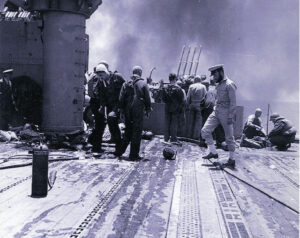The Battle of Midway stands as a pivotal moment in World War II, a turning point that decisively shifted the balance of power in the Pacific. For the Navy, June 4, 1942, remains a sacred date, one that not only celebrates a historic victory but also encourages us to look back on the tremendous courage and sacrifice of all who served. This includes the vital role played by Navy Medicine.
Midway was not just a clash of warships and aircraft. It’s also a testament to the dedication and bravery of the Navy physicians, dentists, and pharmacist’s mates (hospital corpsmen). Navy medical personnel served on every vessel in the Navy Task Forces 16 and 17—from the immense carriers to the nimble destroyers. In the crucible of the battle, medical personnel administered life-saving care to wounded sailors, performed surgery, and stabilized critical injuries with limited resources. And when ships were damaged or sunk, medical personnel often coordinated evacuation efforts while ensuring that the wounded received the care they desperately needed.
Among the many who displayed exceptional heroism at Midway were two of Navy Medicine’s finest:
Lt. John H. Peterson, USS Hammann (DD-412):
Peterson served as medical officer aboard the destroyer USS Hammann at Midway. Although injured by a shock of a torpedo explosion, Lt. Peterson helped lead the evacuation efforts from his ship. Afterwards, he directed the rescue of many seriously wounded sailors who might otherwise have drowned. For three grueling days, he rendered constant medical care to the wounded aboard another destroyer en route to its base, pushing himself to the brink of exhaustion.
Lt. j.g. Edward Augustus Kearney, USS Yorktown (CV-5):
Dr. Kearney’s unwavering commitment extended far beyond his initial duty during the attacks. A Navy physician attached to the ill-fated carrier Yorktown, Kearney helped evacuate the casualties from the sinking ship and led the effort to care for wounded aboard the rescue craft. Kearney volunteered to return to Yorktown as part of a salvage party, helping to collect the dead and prepare their burials at sea. Afterwards, he was assigned to be the medical officer aboard destroyer USS Benham (DD-397) caring for 70 wounded, 45 of whom were in critical condition. His devotion to duty and professional skill as a surgeon, while working without the normal facilities of a sickbay or operating room, are responsible for many surviving Midway and getting to medical facilities on Pearl Harbor where they received advanced care.
Kearney and Peterson were later awarded Silver Stars for their exceptional service at Midway.
While Kearney and Peterson serve as examples of the extraordinary acts of bravery at Midway, they represent only part of the medical support provided. Many will never receive the recognition they deserve, but their collective efforts ensured countless sailors survived to fight another day.
Sources:
Executive Officer’s Report of Action for Period of June 4-June 7, 1942. USS Yorktown. BUMED Correspondence Records, National Archives II, College Park, MD.
Gay, George H. Sole Survivor: The Battle of Midway and Its Effects on His Life. Naples, FL: Midway Pubs., 1980. 320 pp.
Hough, Richard A. The Battle of Midway. New York: Macmillan, 1970. 90 pp.
Peterson, John. Military Times Awards of Valor. Retrieved from: https://valor.militarytimes.com/hero/20777.
